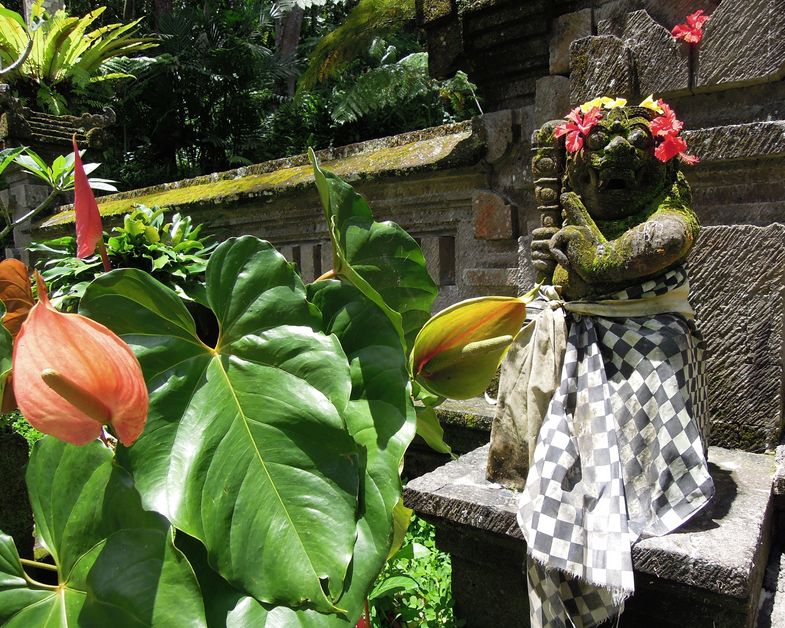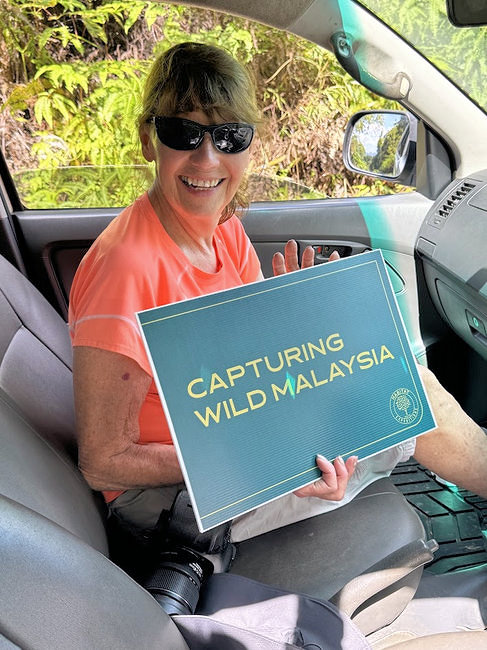HIDDEN BALI…EXPLORING THE SPIRITUAL PATH

Bali is often called the “Island of the Gods” and is on many wish lists for travel. Getting off the plane at the Ngurah Rai airport can be a little disconcerting as the adjacent areas are so commercialized and chaotic with traffic. Don’t be upset as the Bali of your dreams can be still found. It will entail getting away from the hustle and bustle of Kuta and environs. We must visit rural areas such as the Balinese highlands where “hidden Bali” can still be witnessed in all its beauty. This post will take you on paths less traveled as we explore the spiritual side of this amazing island. The photo above shows a carved deity wrapped in a sacred Saput Poleng cloth.
We must begin with religion as every aspect of Balinese life is entwined with Bali Hinduism. The majority of Balinese practice a unique form of Hinduism mixed with Buddhist and animistic beliefs. Although the main Hindu gods are worshipped, equal attention is paid to local, agricultural, and ancestral deities. The Balinese conceive the world as being inhabited by a host of unseen deities, demons, ancestral spirits, and local divinities. The primary focus of much ritual activity is to thank or appease these positive and negative forces to ensure protection and prosperity.

The fascinating rice terraces like these near Tegalalang have a unique cooperative social system, or Subak, controlling the water and disbursement. The Subak is a traditional ecologically sustainable irrigation system and water management plan that binds Balinese agrarian society together with the village’s Bale Banjar community center and Balinese temples.

One of very favorite spiritual destinations in Bali is Pura Gunung Kawi, an 11th-century temple and funerary complex in Tampaksiring northeast of Ubud. As we descend into the river gorge you will see wonderful rice terraces and activities almost frozen in time. Notice the decorated bamboo “penjor” honoring “Dewi Sri”, the goddess of rice and fertility. I recommend a private tour and many hotels provide these services for their guests.

We descend over 200 steps toward the temple below. The woman is carrying supplies for a temple ceremony.

Now this is a balancing act!

Marla with grandsons Paxton & Logan cross a bridge over the Pakerisan river as they near the temple.

You can see 11th century tombs for ancient kings carved in the cliff face and the temple complex.

Village women prepare food offerings for a temple ceremony.

A priest begins chanting.


Praying to the Gods at Pura Gunung Kawai. Tell your guide to arrive at the temple early to escape some of the tourists.


Marla and I encountered this “Mapeed”, or ritual procession. The women are carrying offerings to appease the Gods at a temple.
I shot this while visiting Ubud one year. One never knows when you will encounter a procession.

I took this inside a rural temple on one of my very first trips to Bali.

One of Bali’s more unusual temples is Pura Goa Lawah, or “Bat Cave Temple.” Your guide will provide an appropriate sarong and a sash before entering.

You can see the opening of the bat cave in the background. There are literally thousands of large bats clinging to the walls of the cave. On our very first visit to this temple, we spotted a very large python clinging to the walls! It is said to be a good omen.

Inside the Pura Goa Lawah complex.

Women head up the hill after a ceremony at Pura Tanah Lot, an important temple by the sea.

Another of my very favorite places to visit near Ubud is Goa Gajah Temple. Use a private guide and arrive early as it is very popular. Your guide will provide a sarong and sash to wear as this is a sacred place. This is a holy bathing pond as you enter the complex.

A photo of the bathing pool and the upper complex.

Our guide leads us down the river gorge.

We arrive at the amazing “Elephant Cave” at Goa Gajah. It was originally a Buddhist temple in the 11th century.

Our guide explains the importance of the cave.

A statue of Ganesha sits at the far end of the cave.

We saw a young man making morning offerings to sacred areas of Pura Goa Gajah.

Even this tree is sacred.

I spotted a magnificent carved Garuda in the ceiling of a building in Pura Goa Gajah. Look closely and you can see the Hindu God Vishnu riding the Garuda.

I’m saying prayers at the temple.

One of Bali’s endearing experiences is watching daily offerings, or Canang sari. The placement of the offerings is very deliberate with a small woven tray, frangipani petals, and wafting incense.

On one trip to Bali a young man from our hotel asked if we would like to visit a temple ceremony at a nearby village. It was an exciting experience. Marla admires the many colorful offerings and temple decorations.

A few little shops were set up on the temple grounds serving drinks and snacks.

Marla and I were fortunate to each have a psychic healing session with Ketut Liyer of “Eat Pray Love” fame at his compound near Ubud.

Marla and I made 25 trips to Bali over the years sourcing products to sell to designer clients in our Wesco Fabrics showroom and warehouse. We also hosted 3 sales incentive trips with clients as well. On one trip while staying at the Royal Pita Maha in Kedewatan outside of Ubud our group was invited to attend a cremation ceremony, or Ngaben for an important man in the town. We felt very honored to be invited. Proper respectful sarongs, sashes and hats for the men were given to us. The town temple was busy with preparations.

An important priest is helped through the crowd.

A unique casket (known as “Lembu”) in animal forms like bull, cow, lions, deer or elephant is used in the cremation ceremony. The animal figure chosen for the casket has to be four legs as it symbolizes the four spiritual siblings known as “Kanda Empat”. A bull casket is used for men. The bull is known as the vehicle of Shiva God (The God of death and destruction), so it is considered very prestigious. Another instrument that has to be built is a cremation tower (known as “Wadah” or “Bade”). This tower has many parts attached to it which symbolize the Balinese universe. The turtle and dragon at the base of the tower represent the underworld; above it, there is a world of man represented by leafy forest and mountains painting. At the very top, there is a pagoda-like structure called Meru, which means heaven. This tower can be very tall for important and wealthy people who died.

The ritualistic bull casket.

Final preparations are made to the tower before it is taken to the cremation grounds.

The mesmerizing sounds of a gamelan, drums and gongs increased in volume, almost creating a trance as the priest ignited the tower. The ashes are then carried to the sea or a nearby river in a different ceremony. If you have an opportunity to attend a Balinese cremation ceremony, I highly recommend it. It is something you never forget!
I will post on more of “HIDDEN BALI…OFF THE BEATEN PATH”, and my favorite places to stay on the island in the future.
Photos: Dick Gentry. Not to be used without permission.
About The Author
admin
Related Posts
THE TRAIN TOOK US TO WILD MALAYSIA…TO PENANG AND HISTORIC GEORGE TOWN ON PENANG ISLAND
Our Malaysian adventure continues with a stop at the Taman Negara National Park. Children from…
May 20, 2022AN AMAZING EXCURSION ON THE BELMOND EASTERN & ORIENT EXPRESS THROUGH THE JUNGLES OF MALAYSIA
Having a 3-night Belmond train excursion as a component of our AHI “Treasures…
May 20, 2022

Leave A Comment